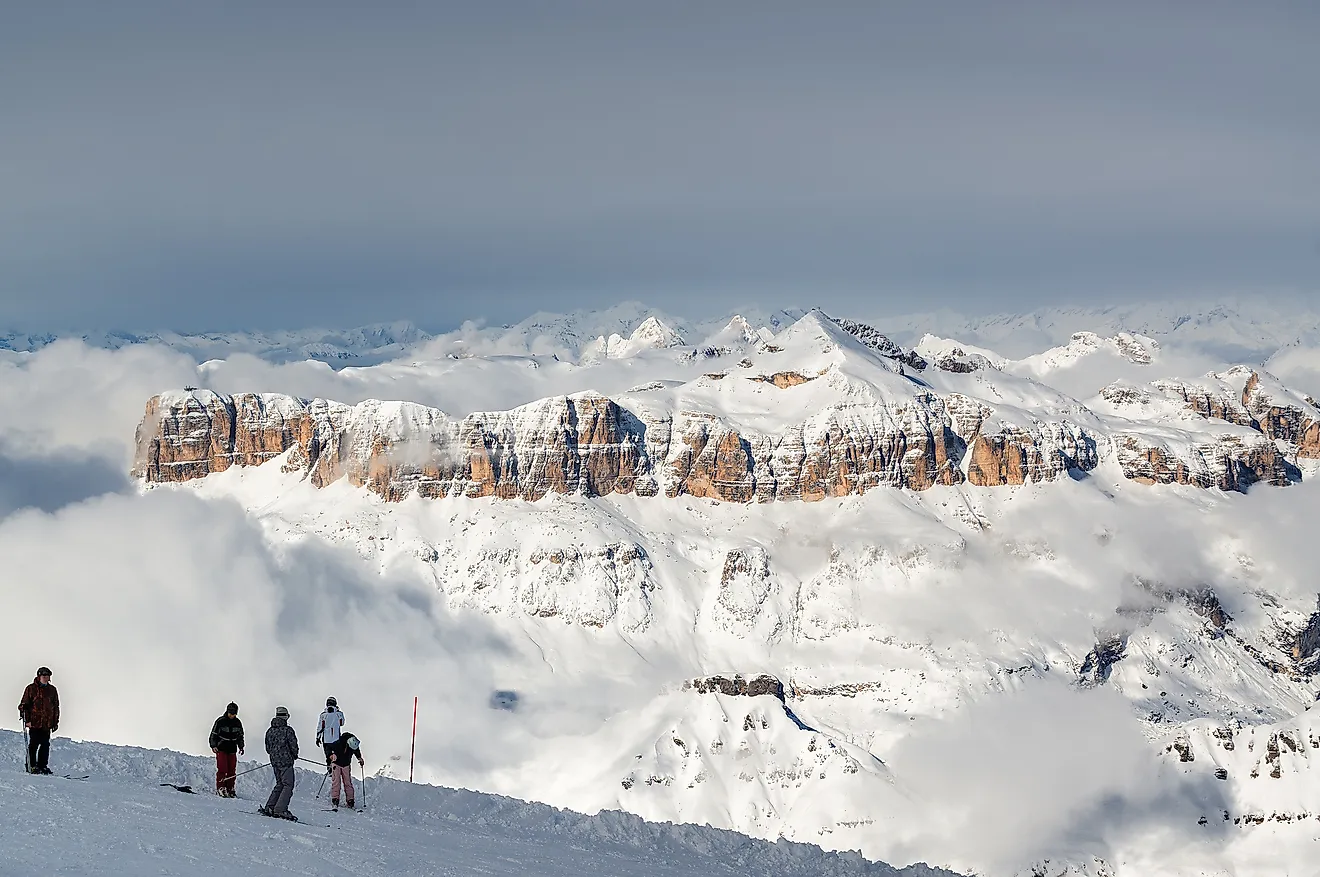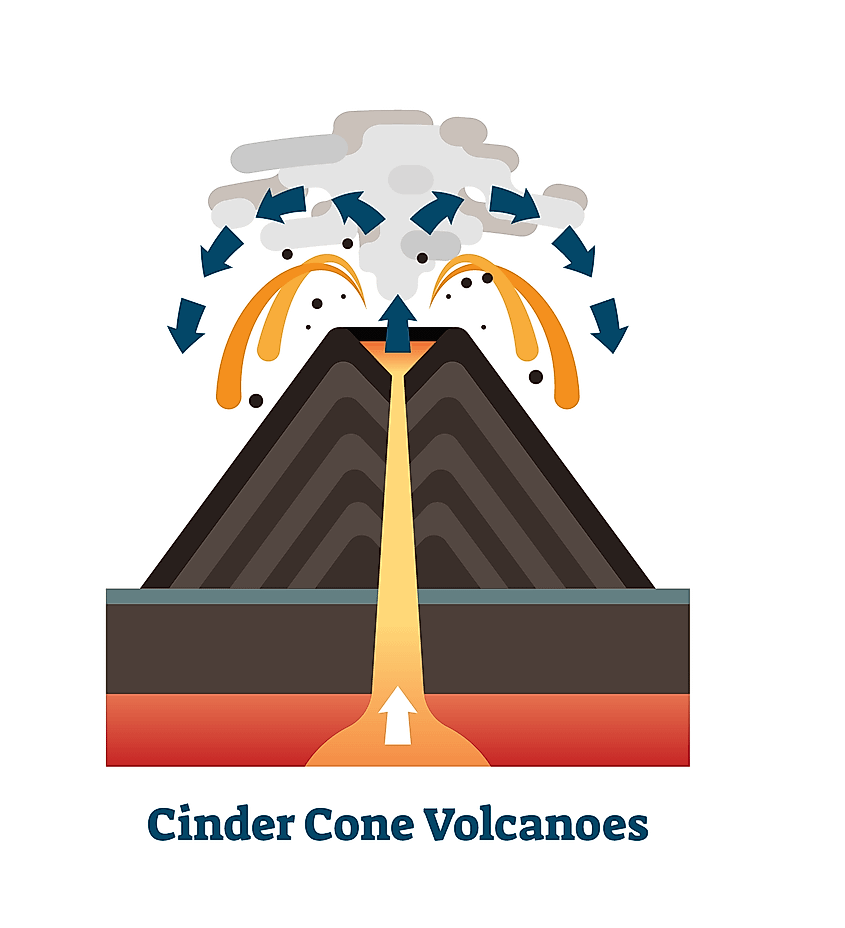
- There are three main catagories of mountains: Volcanic, Fold and Bock
- Mountains are formed along fissures, cracks, or tectonic plate edges, where movement in the earth’s crust causes pressure or friction
- Some of the most famous mountains on earth are, Mount Everest, the Andes mountains, the volcanic islands of Hawaii and Fiji, and the cliffs of the Great Rift Valley
Formation of Volcanic Mountains
Volcanic mountains are formed in areas where there is volcanic activity. This means that there is a place in the Earth’s crust where there is a crack or volcanic vent. Magma, or molten rock, is lighter in weight than the solid rock around it. Because of this, it tends to rise to the surface. Similarly, pressure and heat can build up underground, and force an eruption of lava out of the volcanic areas. This magma bursts out of the ground and creates lava flows, which cool and harden in the open air. Similarly, ash and magma can be ejected high into the air, where they cool and fall to the earth as debris. Both lava flows and debris build up around the volcano’s opening, creating volcanic mountains. In many cases of larger mountains, this process has happened over centuries, with multiple eruptions, slowly building the mountain higher and higher. These two different ways in which volcanoes form mountains are described as cones, or shield mountains.
Cinder Cones

Cinder cone mountains are volcanic mountains that build up when debris is ejected out of a volcanic vent and then rains down to the surface. The nature of the buildup of molten rock and ash also means these mountains are usually more jagged or rough in texture.
Cinder cones exist across the globe, in areas of volcanic activity and plate fissures. They include: Kula and Karapina cones in Turkey, the Taal mountain the Philippines, Hverfjall of Iceland, Paricutin and Pinacate in Mexico, the Luera, Fox and Elephant mountains in Australia, Manda-Inakir, which is found on the Ethiopia/Djibouti border and a number of smaller cones across the North American west coast, in British Columbia, Oregon and California. Nicaragua is home to the most active cinder cone volcano, called Cerro Negro.
Shield Mountains

Examples of shield mountains can also be found in many different countries, including: Santorini, in Greece, Pantelleria in Italy, Fukue-jima of Japan, in a wide variety of cities across Kamchatka, Upolu in Samoa, and Socorro, and San martin in Mexico.
Formation of Fold Mountains
Like all mountains, fold type mountains are created in areas where tectonic plates meet. These areas are known as convergent plate boundaries. Because these are areas where two plates come together, there is often a great deal of friction or pressure that builds up along the plate edges as they shift and move against one another. Fold mountains are created when the plates push up against one another in such a way that the Earth’s crust bends, folds or warps. This process can create large, rippling mountain ranges, or sharp mountains, but usually occurs over thousands or even millions of years. Plates will continue to push up against one another, and the earth will begin to slowly bend and become misshapen as the pressure is maintained.

Other types of patterns in fold rocks include chevron shapes, which describe a zig-zagging edge of sharp, straight folds; slump folds, where folds collapse in on themselves due to soft –usually sedimentary – rock types; ptygmatic where dikes are formed due to viscous material; or disharmonic where a variety of rock formation types are present.
Formation of Block Mountains

Block mountains, also exist in places of faults or along edges of tectonic plates. Unlike fold mountains, that buckle and ripple under pressure, block mountains break into large chunks, or blocks, as cracks in the crust are created from fault lines up to the surface. The extreme pressure caused by tectonic plates pushing against each other, or the gap as they move apart, forces one block of earth upward, and the other down. This type of movement often results in geological formations known as rift valleys, where one area, near a fault, drops down, creating large valleys with steep cliff walls on either side. The greatest example of this phenomenon is the Great Rift Valley which runs from Lebanon all the way to Mozambique.
Due to the way in which block mountains are formed, they tend to have a characteristically block-like shape and appearance. These large chunks of earth rise up out of the ground, in solid, relatively straight-edged pieces. These can be further categorized into one of two main types of fold rocks: tilted and lifted.
Lifted
Lifted block mountains are the type that have mainly been described above. These mountains are created when blocks of the Earth’s crust are forced upward, in a relatively straight motion. This means that the resulting shape is generally flat on top, or tabular, with straight, sharp sides. These sides show clearly the faults or cracks along which the earth broke. These mountains can also be known as horst mountains.
Tilted
The other main type of block mountain is called a tilted mountain, and is made in a similar way with one major difference. While the earth still cracks and splits along a fault due to compression, a tilted rock, as the name suggests, appears to have a tilted angle to it. This is caused by an imbalance in the cracks on either side of the block. Usually, one side, the steeper one, indicates the fault, while the other side is a much more gentle slope. When a crack occurs only on one side of a large chunk of land, that side will jut up, while the other remains, forcing a tilted sloping top. There are a number of well-known block mountains on Earth. The Sierra Nevada mountain in California, USA is known as Earth’s most extensive block mountain. Some other examples include: the Vosges and Black Forest mountains along the Rhine Rift in Europe, the Salt Range of Pakistan, and areas of the Steen Mountain District of Oregon.

